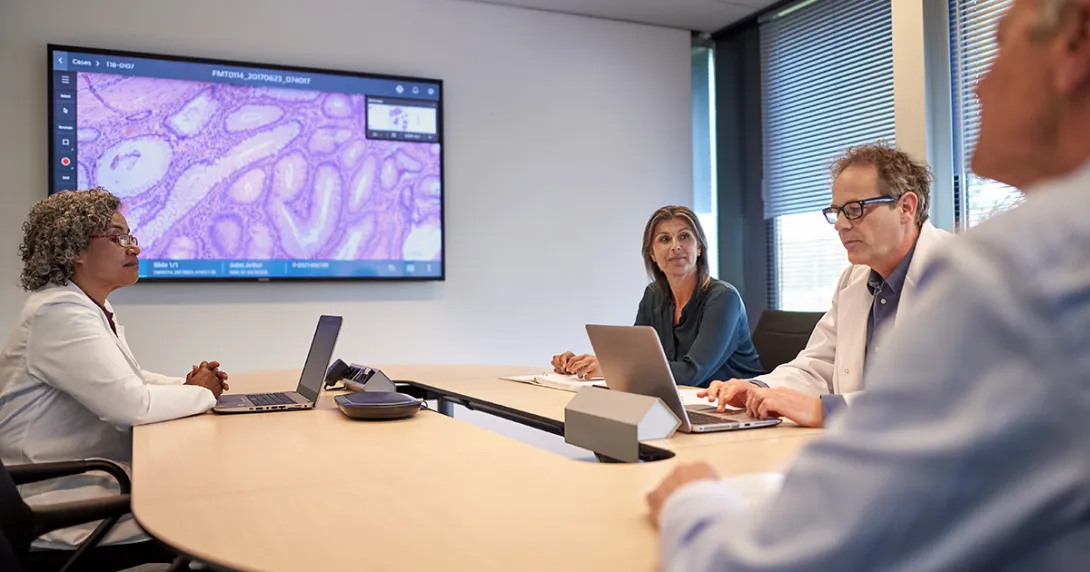
As the demand for pathology-based diagnoses rises, particularly with the growth of personalised cancer care, improved workflow efficiency allows pathologists to manage their growing caseloads more effectively and easily route cases to specialists for remote reading and consultation. However, the transition to digital pathology for primary cancer diagnosis is still ongoing, with many departments continuing to rely on analogue processes that create inefficiencies and delay data access.
Efficiency and enhanced collaboration
Given that by 2050, the WHO expects the number of diagnosed new cancer cases to rise by 77 percent, from 20 million in 2022 to 35 million, the pressure on pathology services is growing. At the same time, the number of pathologists available to deliver those services remains critically low – in Europe, there are just 26.1 pathologists per one million of population, also according to the WHO.
According to recent research, just 23.7 percent of pathologists currently digitise most of their workload. But demand for their services is now helping to drive the adoption of digital pathology more widely. Analogue processes dependent on tissue samples being viewed on glass slides, which are then distributed to other consultants or multidisciplinary team members for second opinions, cannot support today’s workflow challenges or the need for quick, accurate diagnosis.
Digital pathology systems like those developed by Philips can redefine those diagnostic workflows with high-resolution imaging, the ability to integrate artificial intelligence (AI), and remote reading and consultation. This means that pathologists can access and share information more efficiently, route cases to other members of the multidisciplinary care team and obtain second opinions more quickly, and improve overall diagnostic turnaround times, leading to more personalised cancer care.
The impact of digital transformation
This is the experience of pathologists at Paris Saint-Joseph Hospital in France, which has been working in partnership with Philips to integrate digital pathology into its enterprise imaging workflow.
Saint-Joseph and its sister hospital, Marie Lannelongue, are using the Philips digital pathology solution to support multidisciplinary tumor boards in guiding personalised care pathway selection. Between them, the hospitals generate around 150,000 pathology slides every year.
“Digital transformation has proven successful for pathologists, allowing easier organization and more efficient workflows, with new functionalities like measurements and multiple-slide alignment providing better collaboration across the care team and helping improve the path to diagnosis,” says Dr Julien Adam, head of the hospital’s pathology unit.
“Through the partnership with Philips, we aim to integrate all our imaging data into an integrated diagnosis to enhance clinical decision-making and improve patient care."
AI powers productivity gains
When Philips surveyed 52 pathologists, lab managers and lab technicians in Europe, they unanimously agreed that digital pathology helped in reaching diagnostic consensus. According to the same survey, digitalization can help pathology teams to save up to 19 hours a day on case logistics and reading.
With the need for their services growing, pathology labs are also benefiting from digitalization. According to the Philips survey, staff adapt quickly to new systems and can increase productivity by 25 percent. Research suggests that efficiency can rise to at least 30 percent when AI is introduced.
Transforming patient care
The digital transformation of pathology workflows is set to improve laboratory operations and enhance the efficiency of resource-stretched pathologists and their colleagues. Streamlined image analysis, remote collaboration and faster diagnosis are also creating new opportunities for research and clinical collaboration.
For pathology laboratories, the adoption of a digital pathology is proving to be an essential step in supporting clinical teams - one that can help to ensure the best possible path for every patient, by providing personalised and accessible cancer care.
###
Philips has helped more than 300 customers move to a fully digital workflow, with many more using Philips IntelliSite Pathology solution as an open platform for primary diagnosis. Learn more.



